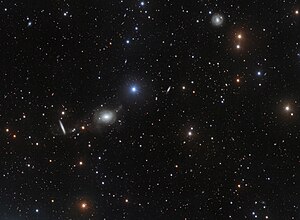NGC 5022
| Galaxie NGC 5022 | |
|---|---|
 | |
| NGC 5022, NGC 5018 (Bildmitte links) | |
| AladinLite | |
| Sternbild | Jungfrau |
| Position Äquinoktium: J2000.0, Epoche: J2000.0 | |
| Rektaszension | 13h 13m 30,8s[1] |
| Deklination | −19° 32′ 48″[1] |
| Erscheinungsbild | |
| Morphologischer Typ | SBb pec sp/HII[1] |
| Helligkeit (visuell) | 12,9 mag[2] |
| Helligkeit (B-Band) | 13,7 mag[2] |
| Winkelausdehnung | 2,5′ × 0,4′[2] |
| Positionswinkel | 21°[2] |
| Flächenhelligkeit | 12,8 mag/arcmin²[2] |
| Physikalische Daten | |
| Rotverschiebung | 0.010010 ±0.000027[1] |
| Radialgeschwindigkeit | 3001 ±8 km/s[1] |
| Hubbledistanz H0 = 73 km/(s • Mpc) | (129 ± 9) · 106 Lj (39,5 ± 2,8) Mpc [1] |
| Geschichte | |
| Entdeckung | Wilhelm Tempel |
| Entdeckungsdatum | 31. März 1881 |
| Katalogbezeichnungen | |
| NGC 5022 • PGC 45952, 45953 • ESO 576-G14 • MCG -03-34-021 • IRAS 13108-1917 • 2MASX J13114576-1915421 • SGC 131050-1917.0 • LDCE 0955 NED017 | |
NGC 5022 ist eine 12,9 mag helle Spiralgalaxie vom Hubble-Typ Sb im Sternbild Jungfrau auf der Ekliptik. Sie ist schätzungsweise 129 Millionen Lichtjahre von der Milchstraße entfernt und hat einen Durchmesser von etwa 100.000 Lj. Sie bildet zusammen mit NGC 5018 ein durch gravitativ gebundenes Galaxienpaar.
Im selben Himmelsareal befindet sich u. a. die Galaxie NGC 5006.
Das Objekt wurde am 31. März 1881 vom deutschen Astronomen Ernst Wilhelm Leberecht Tempel entdeckt.[3]
Weblinks
- Auke Slotegraaf: NGC 5022. Deep Sky Observer's Companion, abgerufen am 24. Februar 2015 (englisch).
- ESO: Kommentierte Ansicht der Umgebung der elliptischen Galaxie NGC 5018
- NGC 5022. DSO Browser, abgerufen am 24. Februar 2015 (englisch).
- ESO: Zoomen auf NGC 5018/5022 (Animation)
- NGC 5022. SIMBAD, abgerufen am 24. Februar 2015 (englisch).
Einzelnachweise
Auf dieser Seite verwendete Medien
Autor/Urheber: ESO/Spavone et al., Lizenz: CC BY 4.0
This deep image of the area of sky around the elliptical galaxy NGC 5018 offers a spectacular view of its tenuous streams of stars and gas. These delicate features are hallmarks of galactic interactions, and provide vital clues to the structure and dynamics of early-type galaxies.
